Books
Books

On the Necessity of Gardening
For centuries, the garden has been regarded as a mirror of society, a microcosm, in which the broader relationships between nature and culture are played out on small scale. From this long cultural tradition also raises a call for a new awareness of our relationship with the Earth.
On the Necessity of Gardening tells the story of the garden as a rich source of inspiration. Over the centuries, artists, writers, poets and thinkers have each described, depicted and designed the garden in different ways. In medieval art, the garden was a reflection of paradise, a place of harmony and fertility, shielded from worldly problems.
However, the garden is not just a neutral place and intended solely for personal pastime, it is a place where the world manifests itself and where the relationship between culture and nature is expressed. In the eighteenth century this image shifted: the garden became a symbol of worldly power and politics. The Anthropocene, the era in which man completely dominates nature with disastrous consequences, is forcing us to radically rethink the role we have given nature in recent decades.
There is a renewed interest in the theme of the garden among contemporary makers. It is not a romantic desire that drives them, but rather a call for a new awareness of our relationship with the earth, by connecting different fields of activity in landscape, art and culture. Through many different essays and an extensive abecedarium, On the Necessity of Gardening reflects on the garden as a metaphor for society, through concepts such as botanomania and capitalocene, from guerrilla gardening to queer ecology and zen garden.
Contributors: Maria Barnas, Jonny Bruce, Laurie Cluitmans, Thiëmo Heilbron, Liesbeth M. Helmus, Erik A. de Jong, René de Kam, Alhena Katsof, Jamaica Kincaid, Bart Rutten, Catriona Sandilands, Patricia de Vries.

Design Dedication: Adaptive Mentalities in Design Education
Design Dedication makes a plea for adaptive mentalities within design pedagogy, with a non-normative approach to design practices. It explores an attitude in and towards design education that is socially engaged, politically aware, generous in approach, lyrical in tone, experimental in form and collaborative in practice. How can we talk about and bring out the political that’s inherent in the work that design students are doing? How to work on specific urgencies that are rooted in experience and narration? What are the underlying values of such a pedagogy? What kind of practices are developed in the context? How can an institute support and safeguard this?
Design Dedication explores these approaches through statements from within and reaches out to design students, designers, artists, and teachers who are open to questioning their own practices and reformulating values in design dedication for a yet unpredictable, but surely dedicated tomorrow.
Contributors: Hannes Bernard, Michèle Champagne, Rana Ghavami, Anja Groten, Agata Jaworska, Anastasia Kubrak, Sherida Kuffour, Gui Machiavelli, Daniel van der Velden, Annelys de Vet and many others.

CAPS LOCK
Capitalism could not exist without the coins, notes, documents, graphics, interfaces, branding and advertisements; artefacts that have been (partly) created by graphic designers. Even anti-consumerist strategies such as social design and speculative design are being appropriated within capitalist societies to serve economic growth. It seems that design is locked in a system of exploitation and profit, a cycle that fosters inequality and the depletion of natural resources.
CAPS LOCK uses clear language and striking visual examples to show how graphic design and capitalism are inextricably linked. The book contains many case studies of designed objects related to capitalist societies and cultures, and also examines how the education and professional practice of (graphic) designers supports the market economy and how design practice is caught within that very system.
The content of CAPS LOCK is structured in chapters with titles of professions that designers can occupy (such as Educator; Engineer, Hacker, Futurist, Activist, etc.). These titles respond to the importance of not just how designers make work, but also how they perform daily economic and social roles.

Fanta For The Ghosts
fanta for the ghosts by Elisabeth Molin
2021, English
46 pages, 120mm x 210mm
edition of 500
Co-published with OneThousandBooks and Elisabeth Molin
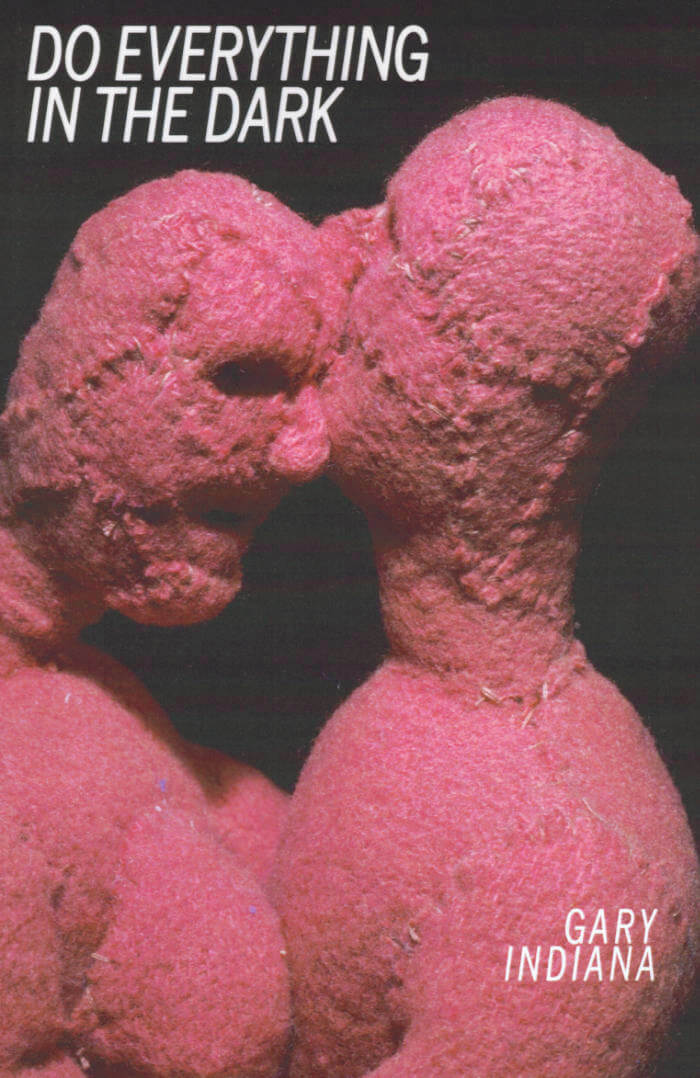
Do Everything in the Dark
Faced with photos of a once-tumultuous New York art world, the narrator's mind in this scathing, darkly funny novel begins to erupt. Memories jostle for center stage, just as those that they are about always did. These brilliant but broken survivors of the '80s and '90s have now reached the brink of middle age and are facing the challenge of continuing to feel authentic.
Luminous with imagery, cackling with bitter humor, this roman à clef spares no one. It's a canny portrait of one era's vaporization, and a study of the perpetual need that some of us feel to reconstruct ourselves-atom by atom.
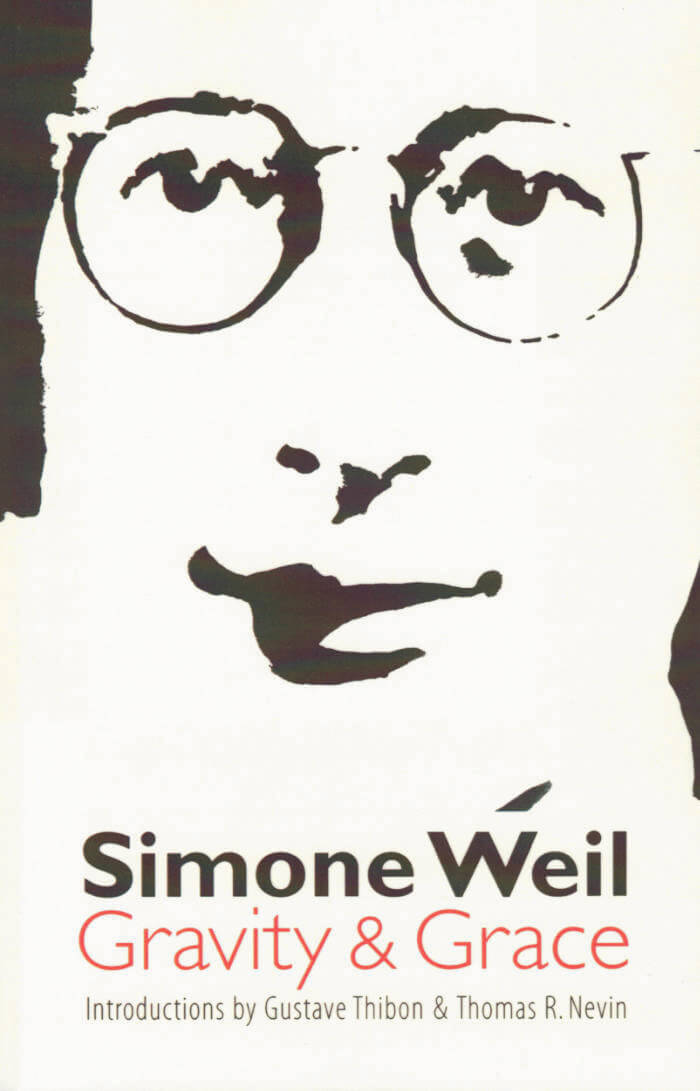
Gravity And Grace
Simone Weil, the French philosopher, political activist, and religious mystic, was little known when she died young in 1943. Four years later the philosopher-farmer Gustave Thibon compiled La pesanteur et la grbce from the notebooks she left in his keeping.
In 1952 this English translation accelerated the fame and influence of Simone Weil. The striking aphorisms in Gravity and Grace reflect the religious philosophy of Weil's last years. Written at the onset of World War II, when her health was deteriorating and her left-wing social activism was giving way to spiritual introspection, this masterwork makes clear why critics have called Simone Weil "a great soul who might have become a saint" and "the Outsider as saint, in an age of alienation." Introducer Thomas R. Nevin is a professor of classical studies at John Carroll University and the author of Simone Weil: Portrait of a Self-Exiled Jew.
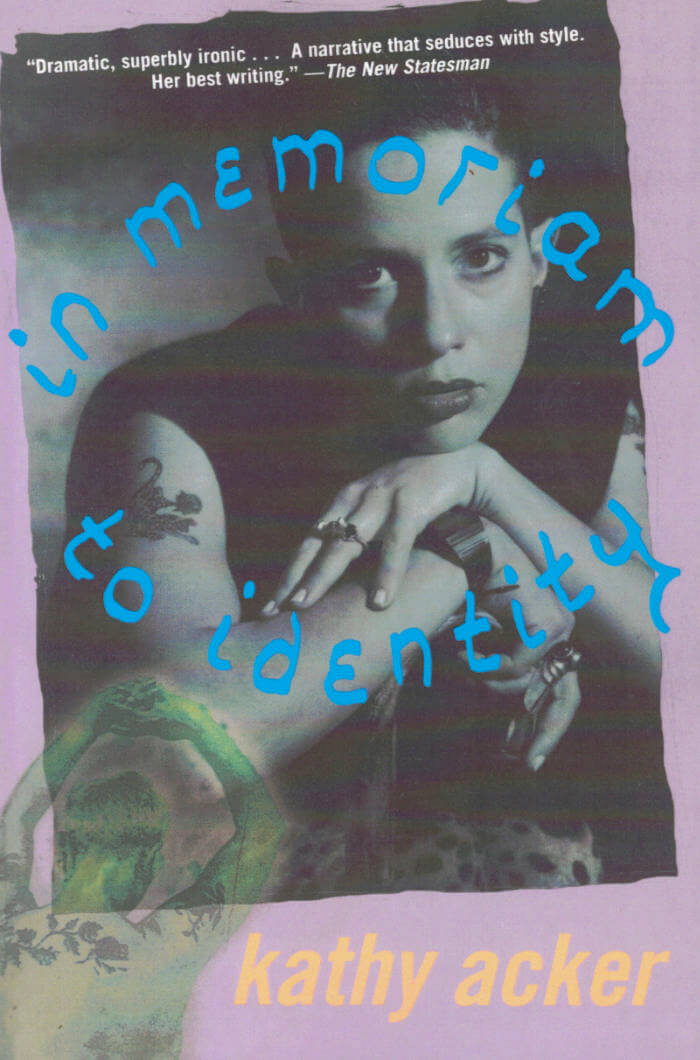
In Memoriam to Identity
In this characteristically sexy, daring, and hyperliterate novel, Kathy Acker interweaves the stories of three characters who share the same tragic flaw: a predilection for doomed, obsessive love. Rimbaud, the delinquent symbolist prodigy, is deserted by his lover Verlaine time and time again. Airplane takes a job dancing at Fun City, the seventh tier of the sex industry, in order to support her good-for-nothing boyfriend. And Capitol feels alive only when she's having sex with her brother, Quentin. In Memoriam to Identity is at once a revelatory addition to, and an irreverent critique of, the literature of decadence and self-destruction.
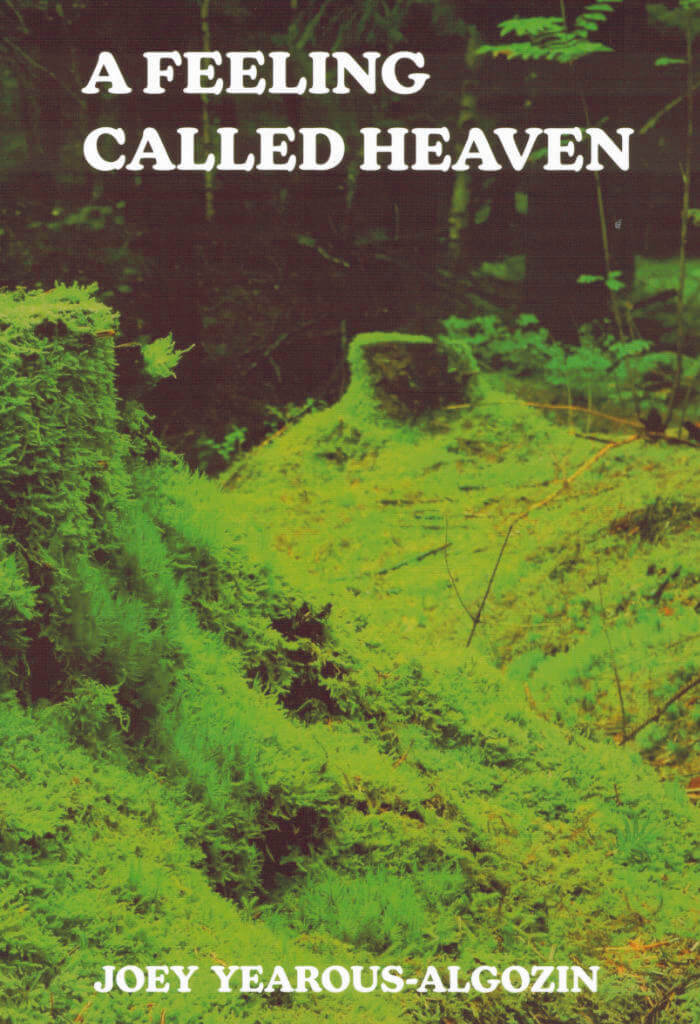
A Feeling Called Heaven
Adopting the role of a death doula or New Age religious leader, and drawing inspiration from the Theater of the Absurd, author Yearous-Algozin prompts readers to accept the already occurring end time. A Feeling Called Heaven oscillates between grief and humor as it imagines the nonhuman world that will grow from the ruins of this one, cultivating a sense of presence and intimacy with the inevitable destruction of our global environment.
Yearous-Algozin is the author of over 20 texts/files including Utopia (2016); Caller Removed (2016); Air the Trees (2012); and the multi-volume work, The Lazarus Project (2010-2013). With Holly Melgard he has co-authored a trilogy of texts: Liqudation (2017), White Trash (2014) and Holly Melgard's Friends and Family (2014). His poetry, poetics, and criticism have appeared in BOMB Magazine, Convolutions, Dreamboat, A Perfect Vacuum, and Social Text, among others. His work has been performed and/or installed at the Museum of Contemporary Art (MoCA), the Museum of Modern Art (MoMA), and The Graphische Sammlung ETH Zürich. Yearous-Algozin is a founding member of the Troll Thread publishing collective and a former co-editor of P-QUEUE (2010-2013). He earned a PhD from the State University of New York at Buffalo and now teaches at Baruch College.
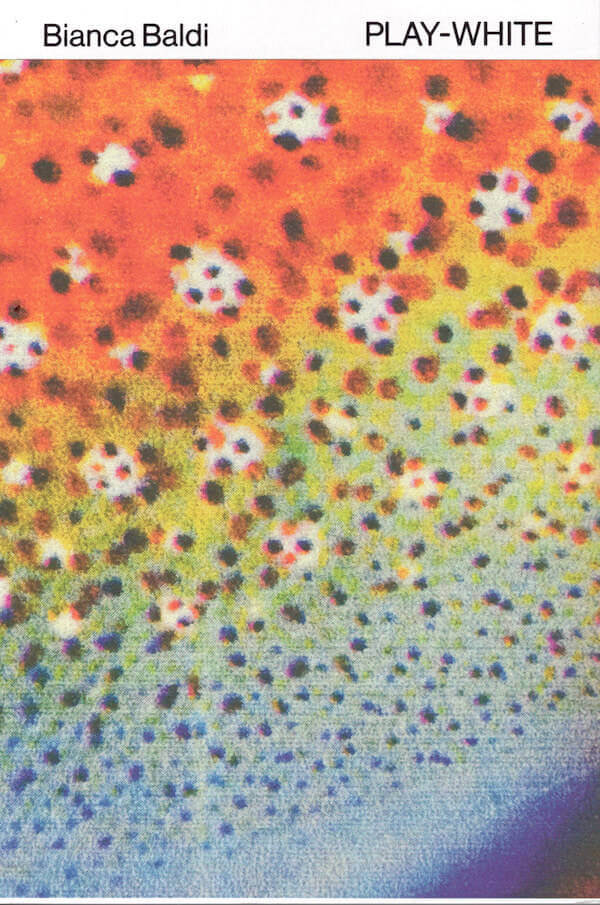
Play-White
The racist term "play-white" comes from the apartheid era, when it connoted a black or mixed race person who lived as a white person: “So and so is a play-white.” South African artist Bianca Baldi draws from studies of biomimicry and her own family history, as well as literary precedents—such as Nella Larsen’s novel Passing (1929)—to reflect on racial passing and the instability of racial identities. Play-White alternates between layers of visualization and moments of discretion in order to explore questions of presence and evasion beyond their representation in black and white.
With contributions by Bianca Baldi, Mika Conradie, Shoniqua Roach, Amy Watson, and others; design by Katharina Tauer & Wolfgang Hückel in collaboration with K. Verlag.
Published 2021
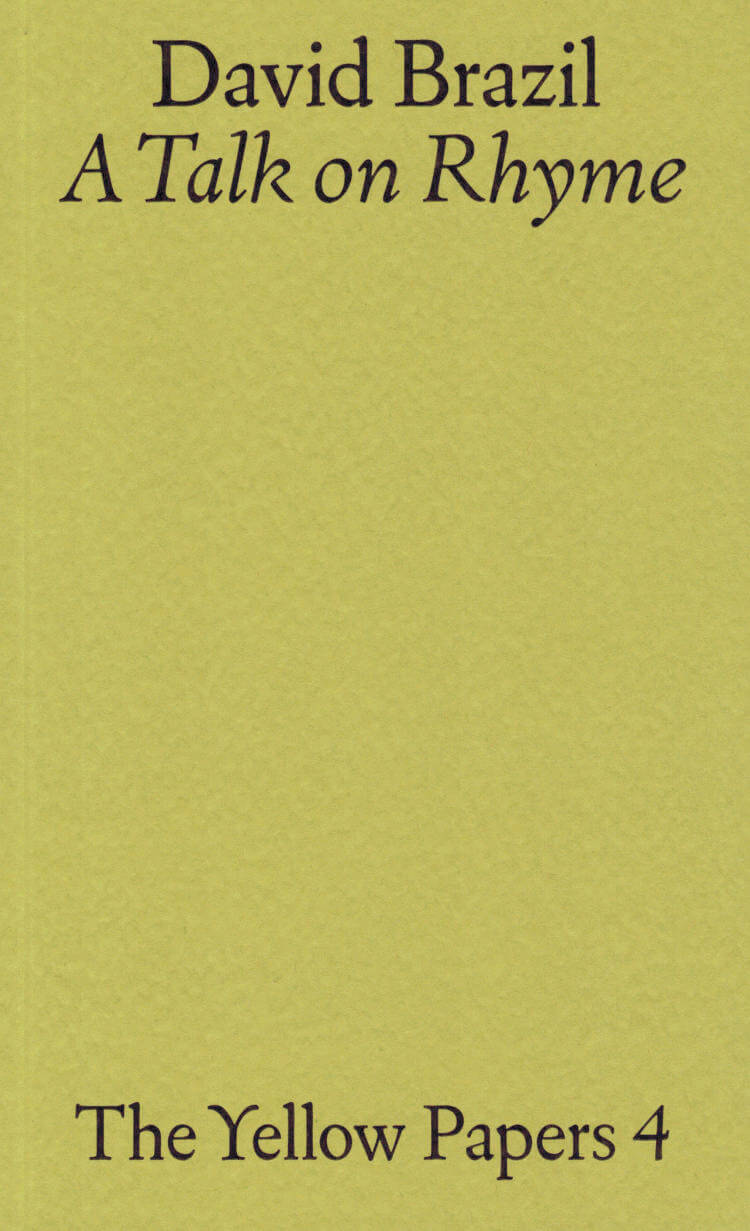
A Talk on Rhyme
In A Talk on Rhyme, a text distilled from a lecture given in 2014, poet David Brazil reflects on rhyme’s “emergence, progress, inoperativity, and prospect.” The Talk is supplemented by an essayistic bibliography on subjects ranging from classical prosody to American folk music, via writings on and by poets long dead whose names are obvious: Saint Paul, Dickinson, Herbert, Spicer, Hölderlin, Dante, O’Hara.

Cristina Campo: Translation / Commentary
Nicola Masciandaro, Andrea di Serego Alighieri
The poet and writer Cristina Campo (Vittoria Guerrini, 1923-1977) is primarily known in Italy as a translator, especially of modernist poetic works and the writings of Simone Weil. Translation was for her an essential task and experience. As Margherita Pieracci Harwell recalls, “the hospitality offered to the poet to be translated, this self-emptying of the interpreter (a participatory offering, in which all the powers of her genius are stretched to the extreme because the other’s voice lives without distortions)—Cristina more than anyone proposed this as a goal.”
This bilingual volume proposes to reflect on this interface of reading and writing by focusing on the commentarial potential of Campo’s work, whose penetrating quality of attention flashes like a spark across the margin between the thing to be transmitted and the act of transmission. In a contemporary context in which the disconnection between the old and the new makes both strictly inaccessible, Cristina Campo’s work stands like a diamond point through which one may reflect on the multitemporal (and eternal) dimension of writing.
With translations and contributions by Andrea di Serego Alighieri, Visnja Bandalo, Laura Boella, Daniela Cascella, Monica Farnetti, Cristina Mazzoni, Nicola Masciandaro, Snejanka Mihaylova, Nicola di Nino, Adrian Nathan West, Chiara Zamboni.
Edited by Nicola Masciandaro & Andrea di Serego Alighieri.
published 2021

Wistlin is did
Chris Mann is an Australian-American composer, poet and performer specializing in compositional linguistics. Mann studied Chinese and linguistics at the University of Melbourne, and his interest in language, systems, and philosophy is evident in his work. Mann founded the New Music Centre in 1972 and taught at the State College of Victoria in the mid-1970s. Mann moved to New York in the 1980s and was an associate of American composers John Cage and Kenneth Gaburo. Mann has recorded with the ensemble Machine For Making Sense with Amanda Stewart and others, Chris Mann and the Impediments, and Chris Mann and The Use. Mann currently teaches in the Media Studies Graduate program at The New School.

Can the Subaltern Speak?
Gayatri Chakravorty Spivak, Estefanía Peñafiel Loaiza
Gayatri Chakravorty Spivak's landmark essay in decolonial thought is animated for a new generation with art by Estefanía Peñafiel Loaiza.
In 1985 Gayatri Chakravorty Spivak's seminal essay, 'Can the Subaltern Speak' transformed the analysis of colonialism. In a deeply divided world Spivak's text interrogated the historical and ideological factors that, by obstructing the potential for certain subjects to be heard, maintained the degraded status of those subjects on the world's peripheries. The text remains, in the third decade of the twenty-first century, as compelling as ever, and affirms the continuing relevance of Marxism to contemporary decolonial thought.
In this Afterall Two Works edition, the essay is given new life in dialogue with especially commissioned artwork by Ecuadorian artist Estefanía Peñafiel Loaiza. Loaiza's preoccupation with questions of visibility and occlusion, the need for and absence of the image, has guide the creation of a mesmerising set of works. These form a visual vocabulary that echoes and refracts Spivak's central terms, bringing new inflections to an enduringly important text.

My Mother Laughs
First published in France in 2013, My Mother Laughs is the final book written by the legendary and beloved Belgian artist and director Chantal Akerman (1950-2015) before her death. A moving and unforgettable memoir, the book delves deeply into one of the central themes and focuses of Akerman's often autobiographical films: her mother, who was the direct subject of her final film No Home Movie (2015).
With a particular focus on the difficulties Akerman faced in conjunction with the end of her mother's life, the book combines a matter-of-fact writing style with family photographs and stills from her own films in order to better convey the totality of her experience. Akerman writes: With pride because I finally believed in my ability to say something that I'd had trouble saying. I told myself, I am strong for once, I speak. I tell the truth.
Chantal Akerman (1950-2015) was a Belgian film director, screenwriter, artist and professor. She is best known for her film Jeanne Dielman, 23 quai du Commerce, 1080 Bruxelles (1975), which was dubbed a masterpiece by the New York Times. During her 42 years of active filmmaking, Akerman's influence on queer, feminist and avant-garde cinema remains unmatched, her films highlighting a near-physical passage of time. Akerman's films have been shown at the Venice Film Festival, Cannes Film Festival and the New York Film Festival, among many others.
Translated by Corina Copp.
Published June 2019.

Hildegard Von Bingen's Physica
Hildegard von Bingen, Priscilla Throop
At a time when few women could write and most were denied a formal education, Hildegard von Bingen became a legendary healer, visionary, musician, artist, poet, and saint. In Physica, Hildegard presents nine "books" of healing systems: Plants, Elements, Trees, Stones, Fish, Birds, Animals, Reptiles, and Metals. In each book she discusses the qualities of these natural creations and elaborates on their medicinal use, explaining how to prepare and apply different remedies. With its emphasis on balancing the humors, Physica has strong affinity with the Oriental medical approaches gaining great respect today.
The modern reader interested in natural healing will recognize the enormous truth in the theories of this twelth-century physician, many of which prove effective today, serving as a reminder that our cures for illness depend on our natural world and our place in it.
As Hildegard states in Physica, "With earth was the human being created. All the elements served mankind and, sensing that he was alive, they busied themselves in aiding his life in every way."
Translated by Priscilla Throop a Latin and Greek scholar, she holds a master's degree from the Centre for Medieval Studies at the University of Toronto, as well as a Certificate of Advanced Theological Studies from the Episcopal Divinity School in Cambridge. She is a member of the Vermont Classical Language Association and is currently translating Isidore of Seville's Etymologiae. She lives in Charlotte, Vermont.
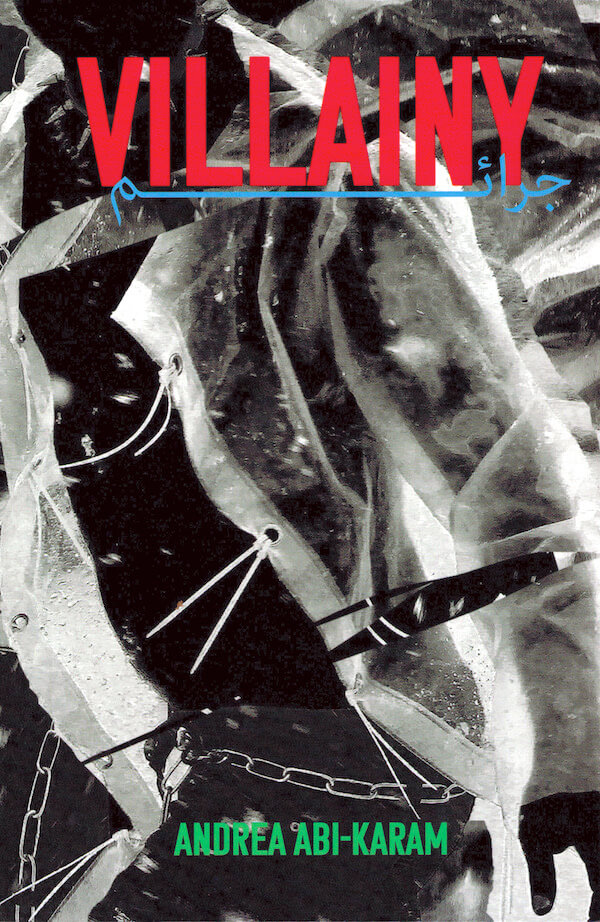
Villainy
Harnessing street protest as a poetic formation, Villainy exhibits the desires that bring queers into public space.
Andrea Abi-Karam answers the call to action for poetry itself to become the radical accomplice it was destined to be in their second book, Villainy. In order to live through the grief of the Ghostship Fire & the Muslim Ban, Villainy foments political action in public spaces, and indexes the various emotional states, such as rage, revelry, fear, grief, and desire to which queers must tend during protest. In scenes loaded with glitter, broken glass, and cum, Abi-Karam insists that in order to shatter the rising influence of new fascism we must embrace the collective work of antifascists, street medics, and queer exhibitionists and that the safety that we risk is reckless and necessary. Disruptive and demanding, these punk poems embody direct action and invite the audience into the desire-filled slippage between public sex and demonstration. At heart, Villainy aims to destroy all levels of hierarchy to establish a participatory, temporary autonomous zone in which the targeted other can thrive.
Published September 2021
Andrea Abi-Karam is an arab-american genderqueer punk poet-performer cyborg, writing on the art of killing bros, the intricacies of cyborg bodies, trauma and delayed healing. Selected by Bhanu Khapil, Andrea's debut EXTRATRANSMISSION (Kelsey Street Press, 2019), is a poetic critique of the U.S. military's role in the War on Terror. Simone White selected their second assemblage, Villainy for publication in Fall 2021 at Nightboat Books. With Kay Gabriel, they co-edited We Want It All: An Anthology of Radical Trans Poetics released by Nightboat Books in November 2020. They are a Leo currently obsessed with queer terror and convertibles.

Short Term Eternity
Anu Vahtra, Gordon Matta-Clark
"Short Term Eternity" brings together two artists – Gordon Matta-Clark (1943–1978, USA) and Anu Vahtra (1982, Estonia) – whose practices are related to each other in many ways, even if they are born in different times and locations. The aim of the book is not just to compare their work, but to describe the circling of ideas and strategies in the art world from a non-hierarchical perspective.
The book is published on the occasion of "Gordon Matta-Clark: Anarchitect. Anu Vahtra: Completion through removal", an exhibition in the Kumu Art Museum in Tallinn, February 22 – June 8, 2019, organised in cooperation between the Bronx Museum of the Arts and the Kumu Art Museum, curated by Sergio Bessa, Jessamyn Fiore, and Anu Allas.
As a contrast to the large-scale installations in both Matta-Clark’s and Vahtra’s practice, the book is small in size. The content is printed on thin paper and is divided into three parts. It starts with Completion through removal, a series of photographs by Anu Vahtra showing the spatial intervention realised in the Great Hall in Kumu and ends with the illustrated script of Vahtra’s performance piece Open House Closing. A Walk. The middle section of the book includes three thoroughly illustrated essays, where the images are printed overleaf from the text and are only visible through the page in a gap in the text at their intended location. These gaps or cuts in the text refer to the empty space, characteristic for the practices of both Matta-Clark and Vahtra.
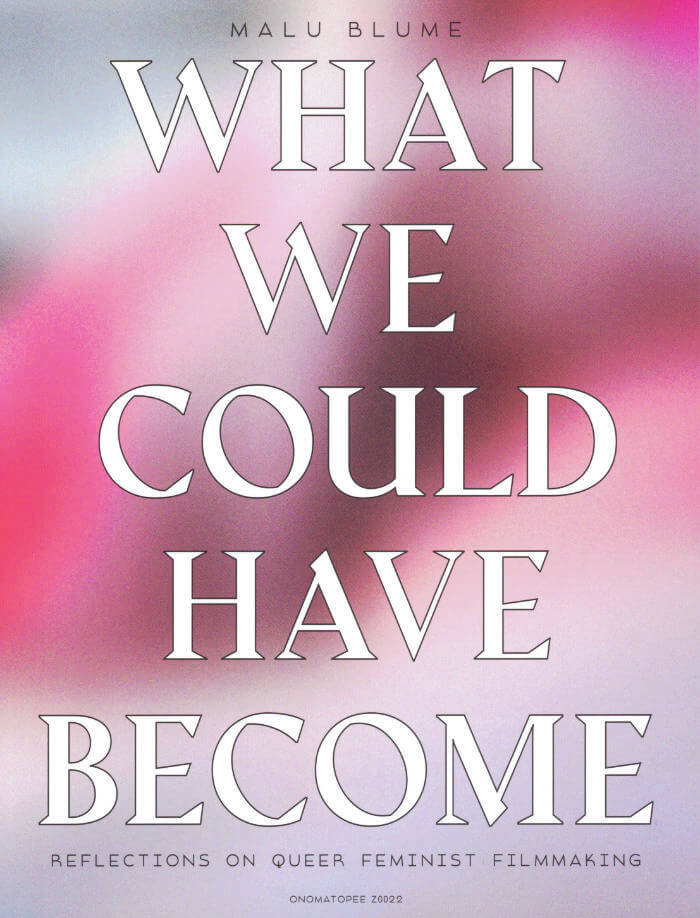
What We Could Have Become
The publication 'What we could have become: Reflections on queer feminist filmmaking' explores the radical potentials of care and speculative fiction in the context of queer feminist collective filmmaking. Departing from the experimental short film The Book of S of I (2020) by Malu Blume, this publication is a documentation of the film project just as much as its own artistic medium. Using a performative mode, it weaves together film stills with unreleased set photography, creating a visual narration that reflects caring and kinship through a queer feminist – and femme – lens.
With a foreword by editor Sascia Bailer, the booklet contains a transcript of the film’s narrative voice over and an essay on queer utopian care in the context of The Book of S of I and its making, both written by the artist Malu Blume. The publication concludes with a conversation between Malu Blume and their co-producers, friends and artistic collaborators Ipek Hamzaoglu, Laura Nitsch and Sophie Utikal, moderated by Sascia Bailer. In this conversation the artists and discuss the chances and challenges of collective film making in the context of producing The Book of S of I.
Malu Blume is a Berlin-based artist who works at the intersections of art, performance, film and education. In 2016 they completed a master's degree in Critical Studies at the Academy of Fine Arts Vienna. Malu Blume has been the co-founder and member of several collective projects on queer feminism, archival politics, friendship and collaborative knowledge production.

Empathy Revisited: Designs for more than one
Ideas, utopian propositions and practical solutions for reinterpreting and reconnecting empathically with the world around us.
This book brings together ideas and projects that seek to define a new role for design based on empathy.
As a mediator of emotions and feelings, design is presented here as a practice that takes care as its main purpose. Designers adopt sensitive, diplomatic, sometimes therapeutic functions, with the aim of connecting us with one another but also with the world around us, with other species, with soil, water and even the universe. In this book, the reader will find new ideas, utopian propositions but also practical solutions for reinterpreting and reconnecting with the world around them. Taking food as a key medium of encounter, both between people and also with the more than human world, the designers featured in this book consciously operate in a multi-scalar realm – from the invisible microbial life that lives in our gut to the vast landscapes transformed by agricultural practices. Designs for more than one are those that take into consideration not just their immediate user or client but the many constituents inevitably impacted by any new object or action.
Edited by Mariana Pestana with Sumitra Upham and Billie Muraben.
With written contributions by Ekin Ozbicer, Mariana Pestana, Susan Lanzoni, Naz Şahin, Billie Muraben, Sumitra Upham, FRAUD, Luigi Coppola and Vivien Sansour and Pelin Tan, Aslıhan Demirtaş, Black Athena Collective, theOtherDada, TiriLab, Counterspace, Anna Puigjaner (MAIO) with Alina Abouelenin, Aslı Uludağ, Dele Adeyemo, Young Curators Group, Eylül Şenses, Ulya Soley, Nur Horsanalı, Studio Ossidiana, Orkan Telhan + elii, Ibiye Camp, Ben Thorp Brown, Paula Gaetano Adi, Meriem Bennani, Calum Bowden, Jawa El Khash, Emmy Bacharach, Alice dos Reis, Macedo Cannat, Future Anecdotes.

Speculative Facts
Department of Speculative Facts
The Department of Speculative Facts connects two seemingly contradictory approaches: Speculation which attempts to think and act beyond existing knowledge and structures, and fact-checkers in search for a solid consensus on which our reality can be built. When stretching knowledge and speculating with fiction, what sense of responsibility is needed in times of democratized opinions and fake news? Learning from the other SF—Science Fiction—we think of speculation through facts, and facts through speculation, to situate truth culturally.
The backbone of this book is an e-mail exchange between two fact-checkers from the New York Times Magazine, which we handed over to artists to re-write, re-perform, and re-design. The publication includes the original letters, workshop scripts, as well as additional texts by philosophers, journalists, writers, and artists looking at new social contracts, with which we can anchor ourselves in the present.
Department of Speculative Facts is Lietje Bauwens, Quenton Miller, Karoline Świeżyński.
Contributions by Sepake Angiama, Lietje Bauwens (DoSF), Kate Briggs, Federico Campagna, Alex Carp & Jamie Fisher (NEW YORK TIMES MAGAZINE), Mette Edvardsen, Tristan Garcia, Maryam Monalisa Gharavi, Nicoline van Harskamp, Quenton Miller DoSF, Ingo Niermann, Michael Portnoy, Achal Prabhala with WIKIAFRICA, FACT FACTORIES, AFRICA CHECK, CHIMURENGA, Wolfgang Tillmans, Bob Trafford (FORENSIC ARCHITECTURE).
Design by Karoline Świeżyński

Philosophy for Spiders: On the Low Theory of Kathy Acker
McKenzie Wark combines an autobiographical account of her relationship with Kathy Acker with her transgender reading of Acker's writing to outline Acker's philosophy of embodiment and its importance for theorizing the trans experience.
Over the decades readers have found a punk Acker, a feminist Acker, a queer Acker, a kink Acker, and an avant-garde Acker. In Philosophy for Spiders, McKenzie Wark adds a trans Acker.
Wark recounts her memories of Acker (with whom she had a passionate affair) and gives a comprehensive reading of her published and archived works. Wark finds not just an inventive writer of fiction who pressed against the boundaries of gender but a theorist whose comprehensive philosophy of life brings a conceptual intelligence to the everyday life of those usually excluded from philosophy's purview.
As Wark shows, Acker's engagement with topics such as masturbation, sadism, body-building, and penetrative sex are central to her distinct phenomenology of the body that theorizes the body's relation to others, the city, and technology.
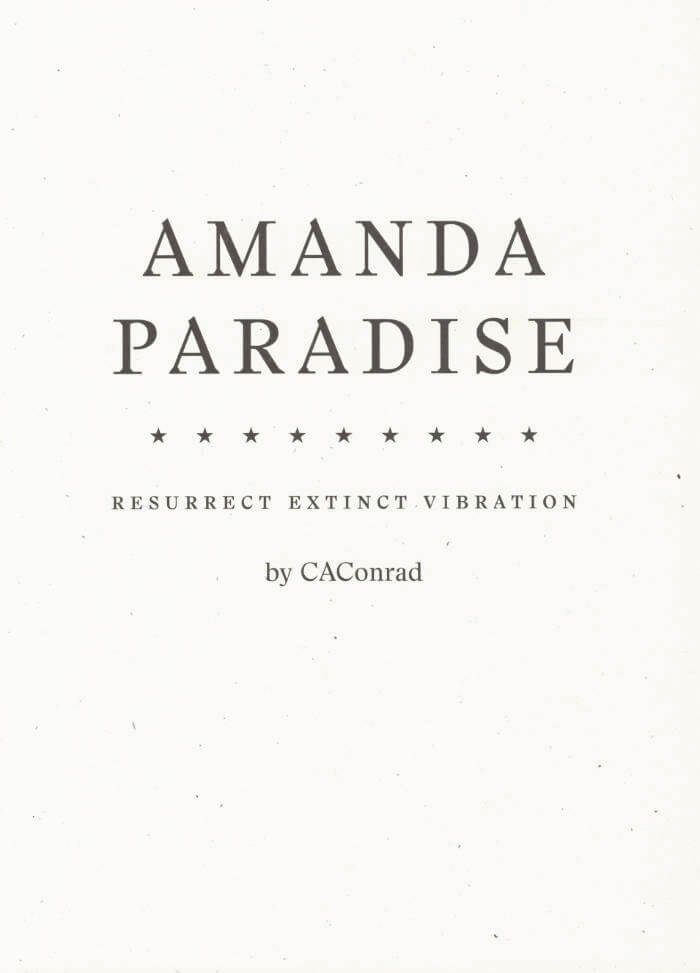
Amanda Paradise
Former United States Poet Laureate Tracy K. Smith wrote in the New York Times, "CAConrad's poems invite the reader to become an agent in a joint act of recovery, to step outside of passivity and propriety and to become susceptible to the illogical and the mysterious."
The poems in AMANDA PARADISE: Resurrect Extinct Vibration reach out from a (Soma)tic poetry ritual where CA flooded their body with the field recordings of recently extinct animals. Foundational here are the memories of loved ones who died of AIDS, the daily struggle of existing through the Corona Virus pandemic, and the effort to arrive at a new way of falling in love with the world as it is, not as it was.

Grave of Light: New and Selected Poems 1970-2005
Selected poems from a visionary feminist poet.
Considered by many to be among the most outstanding of living American poets, Alice Notley has amassed a body of work that includes intimate lyrics, experimental diaries, traditional genres, the postmodern series, the newly invented epic, political observation and invective, and the poem as novel. This chronological selection of her most notable work offers a delineation of her life and creative development. Formerly associated with the second generation of the New York School, Notley has become a poet with a completely distinctive voice. Grave of Light is a progression of changing forms and styles—an extensive panorama held together explicitly by the shape of the poet's times. Notley's poems challenge their subjects head-on, suffusing language with radiant truth.

The Works of Guillaume Dustan (Vol. 1)
Guillaume Dustan' first three novels, published in French between 1996 and 1998, describing the narrator's sexual odyssey through a Paris still haunted by AIDS.
This volume collects a suite of three wildly entertaining and trailblazing short novels by the legendary French anti-assimilationist LGBTQ+ writer Guillaume Dustan. Published sequentially in France between 1996 and 1998, the three novels are exuberant and deliberately affectless accounts of the narrator's sexual odyssey through a Parisian club and bath scene still haunted by AIDS.
In My Room (1996) takes place almost entirely in the narrator's bedroom. The middle volume, I'm Going Out Tonight (1997) finds him venturing out onto the gay scene in one long night. Finally, in Stronger Than Me(1998) the narrator reflects on his early life, which coincided with the appearance and spread of the AIDS virus in France.
A close contemporary of Dennis Cooper, Brett Easton Ellis, Kevin Killian, and Gary Indiana, Guillaume Dustan's deadpan autofiction is at once satirical and intimate, and completely contemporary.